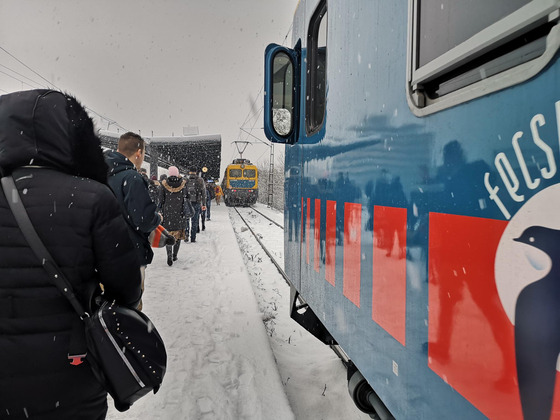Table of Contents
- 1 Rijkswaterstaat: do not come to Groningen via the highway
- 2 Winter showers disappear
- 3 **How did the recent opening of Groningen’s Southern Ring Road contribute to the severity of the traffic disruptions caused by the snowstorm, and what lessons can be learned for future infrastructure projects in similar climates?**
ANPE A stranded truck near the city of Groningen
NOS News•yesterday, 6:02 PM•Adjusted yesterday, 10:53 PM
In the north of the country, the snow has caused many traffic problems this evening. For example, there were heavy traffic jams in and around the city of Groningen and several road users were stranded.
Several trucks were stranded in the underground section of the recently opened southern ring road around the city of Groningen. According to Rijkswaterstaat, they could no longer reach the slope of the sunken section due to slippery conditions, which led to long traffic jams.
“The police are present on the southern ring road to keep things on track,” a Rijkswaterstaat spokesperson previously said. RTV North. “They have difficulty with it, especially when the trucks are heavily loaded.”
After 9 p.m., Rijkswaterstaat announced that the problems around Groningen are “slowly” solving. There are now no more traffic jams on the roads around the city.
Rijkswaterstaat: do not come to Groningen via the highway
The snow also caused inconvenience on other roads. For example, many provincial roads and parts of the A7 could only be driven at walking pace, the ANWB said. Due to the slippery conditions, several vehicles had left the road, such as a truck near Garsthuizen.
Due to crowds, people were advised earlier today to avoid the A28 and A7 towards Groningen for the time being.
The snow also led to traffic problems elsewhere in the country. For example, a truck slid off the road on the A28 in Drenthe. The evening rush hour follows a very busy morning rush hour, with more than 1,000 kilometers of traffic jams at its peak this morning.
The snow led to traffic jams and accidents in various places:
Many accidents due to the slippery conditions today
In Groningen, about 10 centimeters have already fallen locally. In connection with this, the KNMI had declared code orange for the province. Initially, it applied until 11 p.m. tonight, but the code will now remain in force until 8 a.m. tomorrow morning because a lot of snow is still falling and the impact is significant.
“Due to the snow showers, it is still treacherously slippery in the province of Groningen. The situation is not expected to improve until the morning,” the KNMI reports. In many other provinces, code yellow applies until tomorrow morning. Only on the Wadden Islands is no warning in force.
The snow also produces beautiful pictures in the province of Groningen:
Snow in the province of Groningen: ‘It’s winter, wonderful!’
Tonight the temperature inland will drop to slightly below zero and it may become slippery. It may snow again during the night.
Winter showers disappear
Tomorrow there is a chance of winter showers throughout the country. That is the last day we have to deal with winter weather. Saturday is a transition day and Sunday it can be 15 or 16 degrees.
**How did the recent opening of Groningen’s Southern Ring Road contribute to the severity of the traffic disruptions caused by the snowstorm, and what lessons can be learned for future infrastructure projects in similar climates?**
## World Today News: A Deep Dive into the Impacts of Snow on Groningen’s Roads
**Introduction:**
Welcome back to World Today News. We’re diving deep into the winter wonderland that gripped Groningen yesterday, causing major transportation disruptions.
Joining me today are two esteemed guests: [Guest 1 Name], a transportation expert specializing in winter weather mitigation, and [Guest 2 Name], a resident of Groningen who experienced the chaos firsthand.
**Section 1: The Impact on Groningen’s Infrastructure**
* **Interviewer:** [Guest 1 Name], the article details stranded trucks and heavy traffic jams on Groningen’s Southern Ring Road due to slippery conditions. Given its relatively recent opening, were there any specific infrastructural challenges exacerbated by the snow? Do you think this incident highlights any lessons for future road construction projects, particularly in snow-prone regions like the Netherlands?
**Section 2: Real-Life Experiences and Safety Concerns**
* **Interviewer:** [Guest 2 Name], you were in Groningen during the snowstorm. Can you describe your experience navigating the treacherous road conditions?
* **Interviewer:** The article mentions several accidents due to the slippery conditions. What safety measures do you think individuals and authorities could implement to minimize these risks during future snowfall?
**Section 3: The Broader Context of Winter Weather Preparedness**
* **Interviewer:** [Guest 1 Name], beyond road issues, how does a snowstorm of this magnitude impact other facets of city life, like public transportation, essential services, and emergency response?
* **Interviewer:** What are some key strategies that cities like Groningen can implement to better prepare for and respond to significant snowfall events?
**Section 4: Looking Towards the Future**
* **Interviewer:** The KNMI issued a code orange warning and predicted upward of 10 centimeters of snow for Groningen. How effective are these early warning systems in prompting individual preparedness and mitigating the negative impacts of severe weather events?
* **Interviewer:** Looking ahead, with climate change predictions indicating more extreme weather events, what long-term solutions can be implemented to ensure the resilience of infrastructure and public safety in the face of winter weather challenges?
**Conclusion:**
Thank you to both of our guests for sharing their valuable insights. This winter storm served as a reminder of the unpredictable nature of weather and the critical importance of preparedness. It’s essential to learn from these experiences, invest in infrastructure resilience,
and foster a culture of individual responsibility to minimize the disruption and ensure the safety of all citizens.


